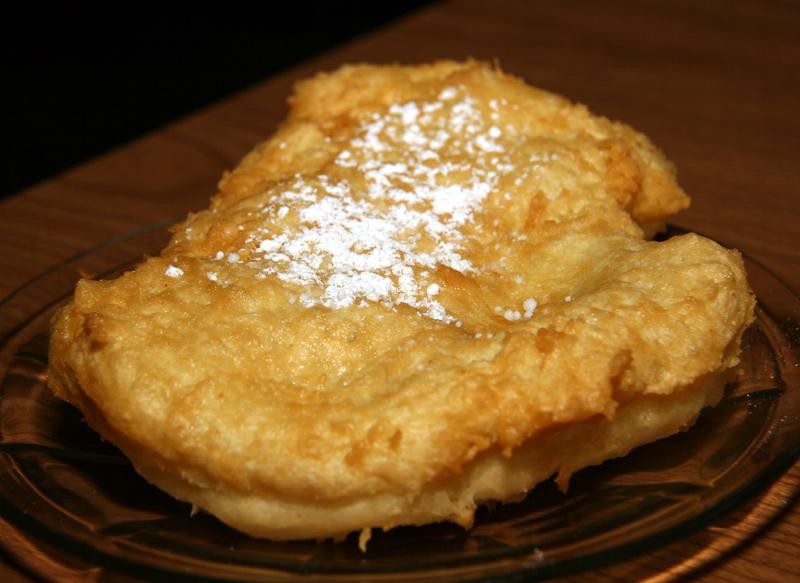Hungry? Don’t have a lot of money? Feel like experiencing some local culture? Indian fry bread may be the dish for you.
Generally known as a carnival treat, Indian fry bread actually has a lot of fascinating history behind it. Fry bread originated early on in Native American reservations, especially on the Navajo reservation, which straddles northern Arizona and New Mexico. After being driven out of their ancestral homes around Canyon de Chelly (a glorious natural wonder near the Arizona/New Mexico border that rivals the Grand Canyon), the American Army packed them onto inhospitable lands.
Forbidden — for the most part — to grow crops or hunt, the Army handed the Navajo token rations, like sacks of flower, powdered milk and a little bit of oil. Instead of caving to the pressure, the Navajo took these ridiculously inadequate foodstuffs and made something out of it: an experiment in ingenuity that became Indian fry bread.
It’s still a staple on the now somewhat more hospitable Navajo reservation, as well as the Hopi reservation, a smaller area completely surrounded by the Navajo. In fact, a lot of Native American cultures still eat fry bread, having created it under similar circumstances to the Navajo.
Knowing this story certainly brings a little more honor and respect to what many in the non-Native American world see as tantamount to funnel cake. Its cultural history also has telling implications about how it’s made — inexpensively, and with expertise mostly borne from experience rather than scientific prowess. Makers of fry bread really ought to have their own special recipe, but to get started here are some ingredient and measurement suggestions.
6 cups of flour
2 tablespoons baking powder
1/2 cup powdered milk
1 can of Crisco
1 deep cast iron skillet
Grilling tongs
The skillet may be the hardest thing to find (the ease of manipulation that a handle brings is a must for seasoned fry bread makers), although a Dutch oven (the camping implement) works alright for depth. Start mixing the flour, baking powder and powdered milk into a large bowl. Then pour a fair amount of hot water into the mix, after which you’ll dig in with your hands and knead the dough the old-fashioned way. Repeat this process (hot water, hand kneading) until the dough is nice and soft, but not too thin.
Now put your bowl aside for about half an hour (some recipes say as long as two hours, but you ought to be good to go), and get out your skillet and Crisco (cooking oil works okay for this too). Boil the Crisco in the skillet on the stove until it’s liquid, and make sure to put in enough so your eventual fry bread will be able to float without touching the bottom.
After you’ve boiled the Crisco, keep the burner at about medium heat for the assembly process. Take your dough (you might want to set down a few paper towels, both to place under your finished product and catch the mess), peel off a wad and roll it into a flat circle, about the size and depth of a personal pan pizza crust. Now carefully put the dough in the skillet.
Watch it until it’s golden brown, flipping it occasionally with your grill tongs to make sure it’s even. When you’re satisfied, use your grill tongs to take it out of the skillet, shake off the excess oil (again, very carefully) and set down to cool. Repeat the process until you’re out of dough.
Now it’s time to eat your cultured creation. There’s the traditional powdered sugar or honey topping for dessert, but if you’d like a full meal try beans, veggies and cheese.
There’s a variety of names for this creation. On the Navajo reservation it’s called a Navajo Taco, while across the border it’s called a Hopi Taco by the Hopi people. Wherever one finds Indian fry bread one finds its taco equivalent, and curiously enough, it’s often named after whichever tribe the reservation belongs to.
Follow us on Twitter @wildcatarts.









